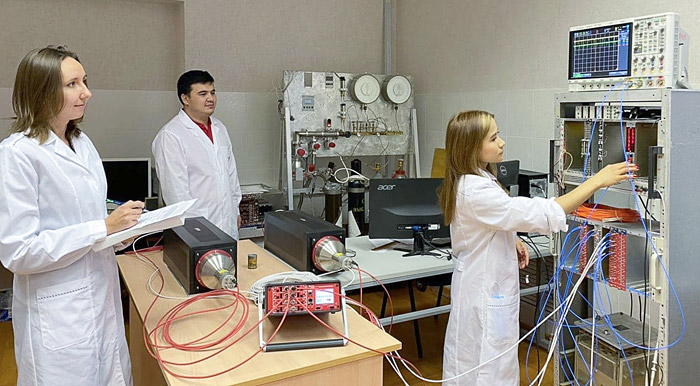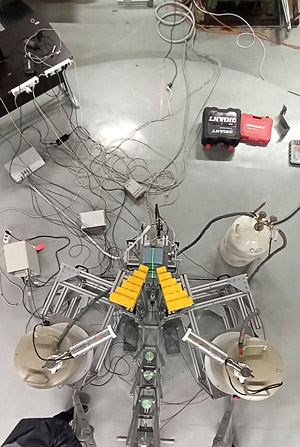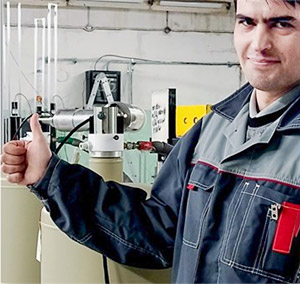
Electronic english version since 2022 |
The newspaper was founded in November 1957
| |
Personal dimension
Nuclear reactions with neutrons -
studied and not very well studied
Nikita Fedorov, Head of the Sector of Investigations of Neutron-Nuclear Interactions of FLNP, graduated from the Faculty of Physics of Moscow State University in 2017 and just five years later, defended his Ph.D. thesis. He tells briefly about himself: "In 2015, I came to JINR for the first time as a fourth-year student, I came to the AYSS conference. I was impressed by the level of organization, the excursions to the facilities and importantly, the social infrastructure. After M. V. Frontasyeva's lecture, I realized that I wanted to join my future with JINR and neutron physics. It was followed by the START summer student programme, work at FLNP as an engineer, a master's degree, a position of junior researcher and afterwards, just as a researcher and later, Ph.D. thesis. Everything is in the TANGRA project. In 2023, I became Head of the Sector and Deputy Project Leader." However, he is ready to talk about science at length and in great detail. His article is dedicated to his favorite work and achievements of the staff, promising research and the significance of the knowledge gained.
Investigations of nuclear reactions with neutrons are one of the main research areas carried out at FLNP. Neutron-nuclear reactions are among the most important sources of data on the structure of the nucleus and the properties of nuclear forces. Accurate data on the probabilities (cross sections) of processes occurring during interactions of neutrons with nuclei are necessary for simulation of promising nuclear facilities, including new generation reactors, as well as for increasing the accuracy of current techniques of elemental analysis and developing new approaches to determining the composition of substances using nuclear techniques.

The staff of the research group for reactions with resonance and fast neutrons is studying the characteristics of detectors
The investigation of nuclear reactions and properties of neutron-nuclear interactions is carried out by the staff of the Sector of Investigations of Neutron-Nuclear Interactions (SINNI). This topic is more than extensive and the following areas can be distinguished:
- investigation of the properties of neutron resonances, search and research of the effects of violation of spatial and temporal parity to test the Standard Model;
- comprehensive research of the nuclear fission process: investigation of TRI and ROT effects in fission, measurement of fission product yields, search for rare and exotic fission modes (quaternary and quintuple fission, fission into three fragments of comparable mass);
- investigation of neutron-induced reactions with the release of charged particles;
- obtaining data for nuclear energy and astrophysics.
Let's discuss these areas in a little more detail and sequentially.
The effects of spatial (P) and temporal (T) parity violation within the Standard Model are explained by the properties of the weak interaction. They appear as individual features of reactions or decays that allow to distinguish the reality in which we live from, for example, a hypothetical world that is a mirror image of ours (spatial parity), or a world in which time goes in the opposite direction (temporal parity). These phenomena are usually studied in high-energy physics, yet studying the properties of nuclear reactions to search for and estimate the magnitude of P- and T-violations has its advantages. On the one hand, in neutron resonances the mechanisms for enhancing the effects of P-parity violation are known and the occurrence of similar mechanisms for T-parity is expected that should simplify the implementation of the experiment. On the other hand, CP parity violation (that according to the CPT theorem, is equivalent to T parity violation) was observed only in the decays of neutral K-, B- and D-mesons and the observation of this effect in other processes, in particular, in nuclear reactions, will be important evidence of the universality of the weak interaction.
Currently, preparations for the investigation of P- and potentially, T-violations are carried out at FLNP. For this purpose, a specialized facility is currently developed at the IREN source that allows to measure the angular distributions of gamma rays emitted in resonance neutron capture, from which the magnitude of P-violating effects can subsequently be determined. In 2023, test measurements were carried out with samples of silver, potassium bromide and niobium. The results obtained will be used to debug the data processing methodology and prepare the next experiments.
The next research area is fission physics, TRI and ROT effects, as well as rare modes are the most widely studied.
It would seem that nuclear fission, the main source of nuclear energy, should already be thoroughly studied. However, there are still many blind spots in this process. In particular, the characteristics of a highly deformed core immediately before its rupture into fragments are of great interest. An idea of what happens before a nucleus ruptures, is provided by the TRI and ROT effects that determine the angular distributions of fission products and influence the radiation emitted by them. Their research was previously carried out at the FRM II reactor in Munich. Currently, work is underway to carry out a similar experiment at the IBR-2 reactor at JINR. Of particular interest is the research of fission that occurs after resonance neutron capture, since in this case the parameters of the initial state are well known. In the near future, experiments on the investigation of the resonance fission of 235U, 241Am and 245Cm will be carried out.
 |
| Facility for studying rare fission modes. A fissile target is installed in the centre of the chamber, surrounded by four Timepix detectors |
The emission of light particles in fission occurs as a result of clustering of nucleons in nuclei, that is uniting into stable groups that in the process of breaking into fragments of the fissioning nucleus can produce a separate nucleus. The investigation of such particles is important for understanding the properties of highly deformed states of heavy nuclei and their angular distribution can be used to estimate the rate of rotation of the nucleus before rupture (ROT effect). Ternary fission is one of the processes resulting in the production of tritium and helium in nuclear reactors and therefore, data on the probability of this process are in demand for applied purposes. An interesting task is the investigation of processes with high multiplicity - quaternary and quinary fission, as well as determining the origin of quaternary particles: whether they are emitted directly when the fissile nucleus breaks (true quaternary fission), or are triple particle decay products. Modern technology can answer this and many other questions. The experiment to study rare fission modes, currently underway at FLNP, uses position-sensitive Timepix detectors that allow to determine the point at which a specific particle hits a sensitive volume, to identify it and to measure its energy. One of the significant results obtained from studying rare modes of spontaneous fission of 252Cf in 2023 is the yield of ternary and quaternary particles. Employees of our sector were able to successfully separate true quaternary fission events and even identify decays of 8Be originating from the ground and excited states. In the future, search for quintuple fission, an even rarer mode, as well as investigation of induced fiss ion will be carried out.
Obtaining nuclear data is a task that is unlikely to lose its relevance in the foreseeable future. It is always necessary to clarify certain characteristics of reactions, to study previously unstudied channels and to carry out measurements on rare isotopes. Data on the processes occurring during the interaction of a neutron with a nucleus is important for testing theoretical models, calculating the parameters of new facilities and predicting radiation damage in materials.
 |
| Assembly of the facility for measuring gamma radiation cross sections |
Another project to study reactions with fast neutrons is TANGRA that uses the technique of tagged neutrons. Its idea is simple: fast neutrons are produced in the fusion reaction of deuterium and tritium, the products of which are α and n. By registering an alpha particle with a position-sensitive detector, it is possible to estimate the direction of movement of the corresponding neutron, as well as to obtain a time stamp of its birth. The energy of the resulting neutrons is about 14 MeV that results in a wide variety of possible reactions in which excited nuclei are produced. The gamma quanta they emit carry data about the characteristics of reaction products and their yields and can also be used to identify individual elements. The compactness of the neutron sources used and the possibility of determining the coordinates of the volume in which the reaction occurred makes the development of elemental analysis techniques with fast neutrons using portable facilities promising. However, it requires well-known cross sections for the emission of gamma rays and their spectra. Work on their production is widely carried out by the TANGRA team, for which a specialized facility has been developed that includes the best available gamma detectors - semiconductor ones made from ultra-pure germanium and scintillation ones based on LaBr3. As part of the project, it is scheduled to measure cross sections for more than 20 elements in 2024.
Personnel decides everything
The research areas implemented in the sector are very wide and not all of them were discussed in this review. For the successful implementation of the research programme, it is highly desirable to attract young qualified specialists that are familiar with current approaches to data analysis, know and love programming and have a good physics education. But... Practice shows that they need to be "grown" starting with very "green" sophomores and accompanying them until they become full-fledged research assistants. Try to ensure that the fire of curiosity and scientific interest does not go out in the process of "growing up" and to do this, set difficult and useful tasks for them. The author of these lines considers one of the most important areas of his work as head of the sector to be the training of young personnel. Particular hopes are associated with Moscow State University and Moscow Institute of Physics and Technology from where, as a rule, the most motivated and qualified students come. Surely, they need to be interested and explained why nuclear physics is a promising and in-demand branch of knowledge. Perhaps, the reader has ideas on what to tell and show, how to attract young people to nuclear or particle physics - in this case, please, contact the author.
 |
| The LED indicates a detector malfunction. You can go home! (Joke) |
To ensure that the flow of young personnel does not stop, we have started holding popular science seminars at the Faculty of Physics of Moscow State University, where we invite scientists from JINR and SINP to talk about their research. After the lecture, students can chat informally with the guest over a cup of tea and perhaps, begin their journey into science. At the end of autumn and beginning of spring, we traditionally invite students interested in excursions to JINR so that they can personally visit where advanced science is carried out.
Sometimes, I am asked whether it is possible to join scientific research with administrative work. I think the answer should be the following: an executive position involves a fairly heavy workload, yet the work is also more interesting than that of a researcher, it requires a wide broadening of one's horizons and not only in physics, it motivates one to develop. Therefore, my advice to those that are just starting their journey is not to be afraid of difficulties and a large amount of work, to engage in self-development, these efforts are always rewarded.